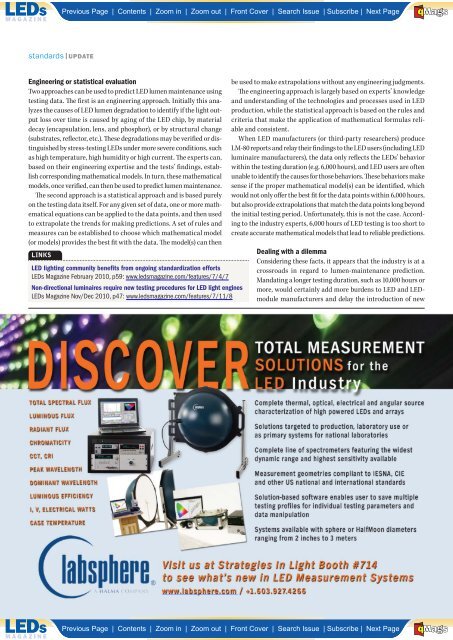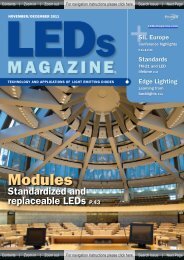The best solutions for any LED measurement application! - Beriled
The best solutions for any LED measurement application! - Beriled
The best solutions for any LED measurement application! - Beriled
You also want an ePaper? Increase the reach of your titles
YUMPU automatically turns print PDFs into web optimized ePapers that Google loves.
standards | UPDATE<br />
Engineering or statistical evaluation<br />
Two approaches can be used to predict <strong>LED</strong> lumen maintenance using<br />
testing data. Th e fi rst is an engineering approach. Initially this analyzes<br />
the causes of <strong>LED</strong> lumen degradation to identify if the light output<br />
loss over time is caused by aging of the <strong>LED</strong> chip, by material<br />
decay (encapsulation, lens, and phosphor), or by structural change<br />
(substrates, refl ector, etc.). Th ese degradations may be verifi ed or distinguished<br />
by stress-testing <strong>LED</strong>s under more severe conditions, such<br />
as high temperature, high humidity or high current. Th e experts can,<br />
based on their engineering expertise and the tests’ fi ndings, establish<br />
corresponding mathematical models. In turn, these mathematical<br />
models, once verifi ed, can then be used to predict lumen maintenance.<br />
Th e second approach is a statistical approach and is based purely<br />
on the testing data itself. For <strong>any</strong> given set of data, one or more mathematical<br />
equations can be applied to the data points, and then used<br />
to extrapolate the trends <strong>for</strong> making predictions. A set of rules and<br />
measures can be established to choose which mathematical model<br />
(or models) provides the <strong>best</strong> fi t with the data. Th e model(s) can then<br />
LINKS<br />
A<br />
Previous Page | Contents | Zoom in | Zoom out | Front Cover | Search Issue | Subscribe | Next Page M S BE<br />
aG<br />
F<br />
<strong>LED</strong> lighting community benefi ts from ongoing standardization ef<strong>for</strong>ts<br />
<strong>LED</strong>s Magazine February 2010, p59: www.ledsmagazine.com/features/7/4/7<br />
Non-directional luminaires require new testing procedures <strong>for</strong> <strong>LED</strong> light engines<br />
<strong>LED</strong>s Magazine Nov/Dec 2010, p47: www.ledsmagazine.com/features/7/11/8<br />
________________<br />
be used to make extrapolations without <strong>any</strong> engineering judgments.<br />
Th e engineering approach is largely based on experts’ knowledge<br />
and understanding of the technologies and processes used in <strong>LED</strong><br />
production, while the statistical approach is based on the rules and<br />
criteria that make the <strong>application</strong> of mathematical <strong>for</strong>mulas reliable<br />
and consistent.<br />
When <strong>LED</strong> manufacturers (or third-party researchers) produce<br />
LM-80 reports and relay their fi ndings to the <strong>LED</strong> users (including <strong>LED</strong><br />
luminaire manufacturers), the data only refl ects the <strong>LED</strong>s’ behavior<br />
within the testing duration (e.g. 6,000 hours), and <strong>LED</strong> users are often<br />
unable to identify the causes <strong>for</strong> those behaviors. Th ese behaviors make<br />
sense if the proper mathematical model(s) can be identifi ed, which<br />
would not only off er the <strong>best</strong> fi t <strong>for</strong> the data points within 6,000 hours,<br />
but also provide extrapolations that match the data points long beyond<br />
the initial testing period. Un<strong>for</strong>tunately, this is not the case. According<br />
to the industry experts, 6,000 hours of <strong>LED</strong> testing is too short to<br />
create accurate mathematical models that lead to reliable predictions.<br />
Dealing with a dilemma<br />
Considering these facts, it appears that the industry is at a<br />
crossroads in regard to lumen-maintenance prediction.<br />
Mandating a longer testing duration, such as 10,000 hours or<br />
more, would certainly add more burdens to <strong>LED</strong> and <strong>LED</strong>module<br />
manufacturers and delay the introduction of new<br />
A<br />
Previous Page | Contents | Zoom in | Zoom out | Front Cover | Search Issue | Subscribe | Next Page M S BE<br />
aG<br />
F

















